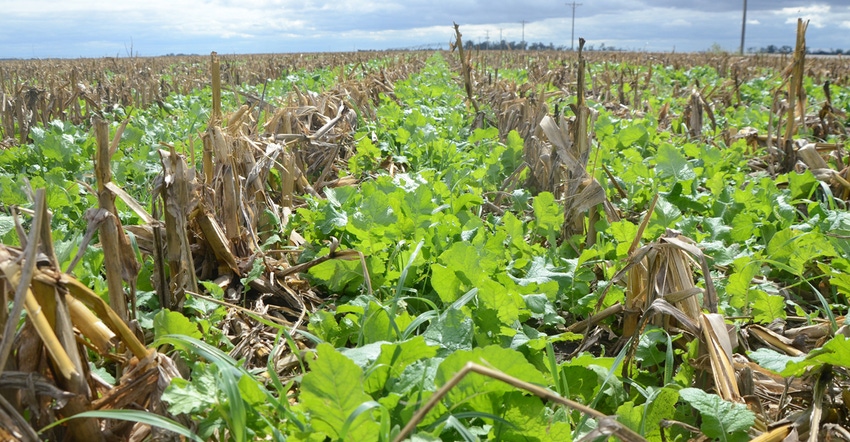
For years, growers have used various means to get an aerial view to detect variability within their cash crop fields. However, researchers at the University of Nebraska-Lincoln have recently applied aerial imagery to detect variability within cover crop fields — and the potential impact of cover crops on subsequent cash crops.
In 2019, Fernanda Souza Krupek, UNL agronomy graduate research assistant, and Andrea Basche, UNL assistant cropping systems professor, began collecting cover crop biomass data from the fields of growers participating in the Nebraska Soil Health Initiative.
This initiative involves growers testing different soil health practices — including various cover crop management strategies. The aerial imagery used to calculate cover crop biomass was provided by TerrAvion.
"We're at the beginning stages of being able to determine how we turn this into a decision," Basche says. "The way I see it is, you're thinking about cover crops in the same way you might think about imagery for cash crops and variability in the field. We know variability can come from soil type, topography and management history. On these farms, what's really unique is we have self-imposed treatments. That's the core of how we've done this analysis."
Souza Krupek explains that the normalized difference vegetation index, which represents the ratio of red to near-infrared wavelengths in crop canopy reflectance, was used to calculate biomass.
"This vegetation index is used to quantify crop reflectance — the solar radiation, the energy that the crop and the soil are reflecting," she says. "This vegetation index is related to photosynthesis and plant health, which means that it can be used to highlight a particular property of the vegetation. There are many different vegetation indices, but we chose NDVI because it maximizes the ability to differentiate between healthier or higher biomass and lower biomass plants."
After collecting images, they also took ground measurements to correlate the NDVI values to cover crop biomass, taking different cover crop management strategies into account.
These management strategies included different planting dates, cover crop mixes versus single species, and grazing versus nongrazed — although it's important to note these were all at different locations, so the different treatments aren't always directly comparable, Souza Krupek notes.
"Take two fields with different planting dates, for example — one in Howard County and the other in Greeley County, where they were testing cover crop mixes versus a no cover crop check," she says. "For the Howard County field, the cover crop was seeded in September, and in Greeley County, the cover crop was seeded in November.
"There was a difference of up to 2,600 pounds per acre in biomass, with a higher biomass in Howard County because it was planted earlier. But we need to keep in mind it wasn't just planting date affecting the values. The species used was also different."
After collecting the imagery on the 2019 cover crops, Souza Krupek and Basche collected aerial NDVI imagery on subsequent cash crops during the 2020 season, allowing them to detect field variability during the growing season, combine it with end-of-season yield data, and determine differences in fields where certain cover crop management practices had been used.
In other words, this may indicate how cover crop practices might affect subsequent cash crops —whether that's sequestering, fixing or tying up nitrogen, or using or retaining moisture. In addition to NDVI values, they also collected thermal imagery to monitor patterns in crop growth and canopy development.
"One field really caught our attention because we noticed that the biomass of the soybeans was lower, and the canopy was not closed in early July in areas that were previously in cover crops," Souza Krupek says. "We noticed at the end of the growing season there was actually a shift, and in the areas with cover crop history, the NDVI values were higher. A few days before the farmer harvested his soybeans, we went to the field and noticed the areas that had a cover crop were still green."
"When we combined the thermal imagery, NDVI values and field assessments we did at the end of the season, we observed that the cover crop slowed the establishment and soybean canopy closure, but the yield data doesn't show any difference," she adds. "We even did some grain quality analysis, and saw no difference. One thing that might have played a role is the fact that the farmer terminated right before he planted. Usually, farmers leave a window between termination and planting, but in this case, he planted two days after cover crop termination."
Basche notes that while this is only the beginning stage, there is potential for growers to use aerial imagery and vegetation indices as a tool to manage cover crops.
"It's a million dollar question everybody wants to know: How are cover crops impacting my cash crop?" she says. "I think we are inching closer to using imagery as a tool to understand our cover crop, how it's growing in our field, how it's affecting our cash crop, and potentially altering the management of the cover crop in the future. Right now, it's a bit more diagnostic or observational, but we can use this information to make decisions on a sub-field level in the future."
Editor's note: The Nebraska On-Farm Research Network does not endorse the use of the products tested in on-farm research trials. While treatments are replicated within trials and may be replicated across multiple sites under various conditions, individual results may vary.
About the Author(s)
You May Also Like






